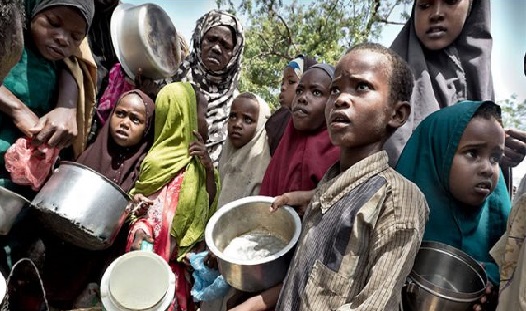Comments and Issues
Hunger is real and present
Published
9 months agoon

Hunger is widespread and chronic in Nigeria, and its prevalence is one phenomenon that statistics cannot fully capture; not even the global hunger index does justice to it. Statistics deals with numbers, but hunger deals with humans. Relying on quantitative data alone to assess the state of hunger in Nigeria is the worst mistake anybody could make. Quantitative data and analysis only show patterns and spread of hunger without delving into the individual lived experiences of those affected and its influences on their existence in all ramifications. Therefore, as bad as the statistics are, they are still child’s play compared to the rich information from qualitative data chronicling the dehumanising lived experience of many poor and hungry Nigerians around us. Combining quantitative and qualitative data paints a horrifying picture of Nigeria’s food crisis and hunger.
According to UNICEF, about 25 million Nigerians are at risk of facing hunger between June and August 2023. Given the current food inflation sweeping the country, we fear even more people may join the ranks. Many families today cannot afford essential food items, even among the middle class. Careful observation during events and functions will reveal how “Item 7 “has gained new prominence among participants. People scramble for food; some even take food home for their families. Before now, low-income families manage to eat twice daily, but now that is a luxury they cannot afford. Family heads and breadwinners are bitterly complaining that their ‘take home’ barely gets home much more to cover the cost of food and other necessities of life. Hunger has a new face, and you can see it in the faces of vulnerable adults and children who look malnourished or are on the brink of starvation. Children are the most vulnerable to food insecurity. Approximately six million food-insecure Nigerians today are children “under 5” living in Borno, Adamawa, Yobe, Sokoto, Katsina and Zamfara states, and there is a severe risk of mortality among children attributed to acute malnutrition, posits UNICEF.
There is no gainsaying the devastating effect of hunger in Nigeria. Some parts of the country are affected the most, primarily due to conflicts, insecurity and climate change that have either stopped agricultural activities or have led to massive movement of people from farming and grazing zones to IDP centres dotted across the country. Other parts of the country not affected by this are feeling the pinch of hunger due to the recent high cost of energy and its impact on transportation that led to an astronomical rise in the price of food items, and effectively and gradually putting food (not even quality, nutritious food) out of the reach of many Nigerians.
A few structural issues exacerbating hunger in Nigeria include poverty – a significant portion of the Nigerian population lives below the poverty line, which limits their access to necessities, including food; lack of economic opportunities for many people – lack of job opportunities or the availability of low-paying jobs can result in inadequate income to afford enough food; inefficient agricultural practices; agricultural challenges that impact food production and its value chain; harsh environmental conditions including irregular rainfall patterns, droughts, and flooding; rapid population growth; limited access to education; poor infrastructure including roads (accessible rural roads to transport food easily), storage facilities, and electricity; lack of investment in agriculture; inefficient governance; weak policy implementation; and inadequate coordination among government agencies. No doubt, food security and fighting hunger had not been our priority, and the problem is now staring us in the face.
Today, the incidence of hunger has increased and expanded . Hunger amongst the populace is a clear and present danger which, if not addressed and effectively managed, could lead to the breakdown of law and order. A hungry man is an angry man. This angst gradually flows into the street and may have severe consequences if not checkmated. This partially explains why the average Nigerian is angry and aggressive on the street. There is a vast population of Nigerians that hunger can wipe out if nothing serious is done in the short term. Hunger dehumanises people and pushes them into a life of crime, superstition, and penury.
The devastating effect of hunger in Nigeria includes malnutrition with its concomitant health problems such as child cognitive developmental delays, stunted growth, weakened immune systems, and increased susceptibility to diseases. Maternal and child mortality rates are also higher in areas with high hunger levels. Second, hunger can hinder children’s access to education. Malnourished children often have reduced energy and focus, making it difficult to engage in learning activities effectively. Third, it can lead to reduced productivity and economic potential. Malnourished individuals are less likely to be able to work and contribute fully to their communities and the economy. Fourth, hunger and poverty are interconnected. They can limit people’s ability to work and earn a living, perpetuating the cycle of poverty for generations. Fifth, persistent hunger can hinder the development of a skilled and productive workforce, which is essential for the long-term growth and stability of the country.
Besides, we must learn lessons from other countries that have faced similar difficulties and got out of it. I propose we study the situation in INDIA in the 1950s and 1960s when it was the hunger epicentre of the world. India was referred to as the “begging bowl nation” because of the devastating impact of hunger on the nation. They have reduced the case of hunger and lifted themselves out of the world’s dungeons of poverty and hunger epicentre. Nigeria is ingloriously moving towards holding this nefarious record. Also, in 2015, India put together a National Food Security Act, which helped 800 million people access publicly financed or subsidised food as an interim measure to fight hunger.
It is essential to acknowledge that hunger is a complex issue with deep-rooted causes, and sustainable solutions require collaboration, resources, and long-term commitment from various stakeholders. Addressing hunger in Nigeria needs a multifaceted and comprehensive approach that involves efforts from the government, non-governmental organisations, international agencies, and the private sector. The pertinent question begging for an answer is: how do we solve the hunger problem that is increasing at an alarming rate in Nigeria today?
ALSO READ: Change starts with you
Fortunately, this administration professes to take the war to hunger. Acknowledged governments don’t feed people but can create food security through economic policy . The president recently declared a state of emergency on food insecurity and marshalled out programmes and activities his administration will undertake in the short term to tackle the menace of hunger in Nigeria. His administration has mobilised over half a billion dollars for innovative and sustainable food systems transformation initiatives. The government has developed its Value Chain Development Programme (VCDP) as a unique example of a successful partnership between producers, the public sector, and private operators. The VCDP aims to empower vulnerable farmers and youth to engage in commercial partnerships with some of the world’s most extensive food processing and marketing firms and capacitate Nigeria’s rural smallholders and operators, youth and women living below the poverty line to take advantage of the new Special Processing Zones.
The president, in his recent speech to the nation, promised to ensure prices of food items remain available and affordable, and he ordered the release of 200,000 metric tonnes of grain from strategic reserves to households across the country and 225,000 metric tonnes of fertiliser, seedlings, and other farm inputs to farmers. His administration will support the cultivation of 500,000 hectares of farmland with crops such as rice, maise, wheat, and cassava. I pray that the impact of these measures will be significant and will be the foundation to build on in the coming years in this fight against hunger.
These efforts are noteworthy in the interim and will help alleviate the pangs of hunger in the land in the immediate future. I will further advocate for a more aggressive push to stem the tide of hunger. We do not have time to wait for short, medium, or even long-term measures. We need to activate emergency measures that will have an immediate impact now. Farming and food production takes a session (sometimes up to one year from planting to harvesting and food on a plate). We do not have the luxury of time to intervene in this hunger menace. I applaud the government’s decision to release grains from the strategic reserve depots, but it must ensure these grains get to hungry Nigerians at affordable prices.
There must be a deliberate engagement of public, private and third sectors to efficiently leverage resources, expertise, and network to implement these emergency hunger alleviation measures. There may be a need for providing emergency food assistance to people significantly affected, providing food price monitoring and control (commodity market boards), strategic food reserves and distributions, providing widespread nutrition programmes, subsidising agricultural inputs, and in extraordinary circumstances, direct cash transfers to low-income families that are in dire need.
It is significant to note that this is a learning curve for Nigeria. Conquering hunger or food poverty will be one of the greatest benefits of democracy in our clime . In summary, the way out of this hunger problem is through sound economic policies that make agriculture attractive (particularly to the youth), as well as institutional reforms that protect land tenure, raise farmers’ productivity, boost supply, and lower prices to consumers, while also ensuring good returns for agricultural investment.
Trending

 Health & Fitness5 days ago
Health & Fitness5 days agoMalaria Vaccines in Africa: Pastor Chris Oyakhilome and the BBC Attack

 Aviation1 week ago
Aviation1 week agoWhy some airlines are avoiding Nigeria’s airspace–NAMA

 Aviation6 days ago
Aviation6 days agoJust in: Dana airline crash lands in Lagos

 Aviation6 days ago
Aviation6 days agoNSIB begins investigation into Dana Air after crash-landing incident

 Aviation6 days ago
Aviation6 days agoJust In: Dana Air plane crash-lands in Lagos

 Aviation5 days ago
Aviation5 days agoJust in: FG suspends all Dana Air operations

 Featured3 days ago
Featured3 days agoGov, Abiodun appoints Chess master, Onakoya sports ambassador

 Crime3 days ago
Crime3 days agoVandalism: Osun water corporation appeals to residents

